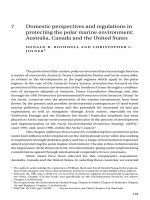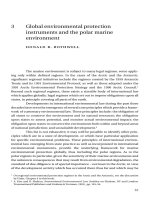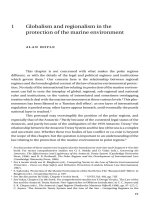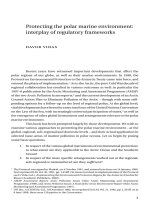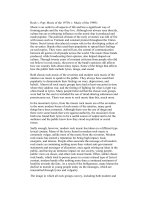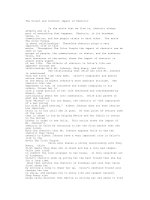Protecting the polar marine environment - interplay of regulatory frameworks
Bạn đang xem bản rút gọn của tài liệu. Xem và tải ngay bản đầy đủ của tài liệu tại đây (94.11 KB, 14 trang )
Protecting the polar marine environment:
interplay of regulatory frameworks
Recent years have witnessed important developments that affect the
polar regions of our globe, as well as their marine environments. In 1998, the
Protocol on Environmental Protection to the Antarctic Treatycame into force, and
entered the phase of implementation.
1
As to the Arctic, the post-ColdWar decade of
regional collaboration has resulted in various outcomes as well: in particular the
1997–8 publication bythe Arctic Monitoring and Assessment Programme (AMAP)
of the two Arctic Pollution Issues reports,
2
and the current development of an Arctic
Council Action Plan to Eliminate Pollution of the Arctic – though with some still-
pending options for a follow-up on the level of regional policy. At the global level,
vital developments have been the entryinto force of the United Nations Convention
on the Law of the Sea, with increasinglyuniversal participation of states,
3
as well as
the emergence of other global instruments and arrangements relevant to the polar
marine environment.
This book has been prompted largely by those developments. We wish to
examine various approaches to protecting the polar marine environment – at the
global, regional, sub-regional and domestic levels – and their actual application in
selected issue-areas of marine pollution in polar oceans. Let us begin by posing
some basic questions.
1. In respect of the various global instruments of environmental protection:
to what extent are they applicable to the Arctic Ocean and the Southern
Ocean?
2. In respect of the more specific arrangements worked out at the regional,
sub-regional or national level: are they sufficient ?
3
1
The Protocol was signed in Madrid, on 4 October 1991, and entered into force on 14 January 1998.
Text reprinted ILM, Vol. 30, 1991, pp. 1,416ff. On issues involved in implementation of the Protocol
see D. Vidas (ed.), Implementing the Environmental Protection Regime for the Antarctic (Dordrecht:
Kluwer Academic Publishers, 2000).
2
AMAP Assessment Report: Arctic Pollution Issues (Oslo: Arctic Monitoring and Assessment
Programme, 1998); and Arctic Pollution Issues:A State of the Arctic Environment Report (Oslo: Arctic
Monitoring and Assessment Programme, 1997).
3
UN doc. A/CONF.62/122, 10 December 1982; text reprinted in ILM, Vol. 21, 1982, pp. 1,261ff. As at
8 June 1999, there were 130 parties to the Convention.
Why focus specifically on the polar regions? And why approach protec-
tion of their marine environments in a comparative fashion? As to the latter ques-
tion, despite the abundance of studies on marine environmental protection,
comparative studies of different regional marine environment protection regimes
are still rare.
4
As we leave the 1990s, it is timely to assess marine environmental pro-
tection regimes applicable to the two polar regions which have witnessed such vital
developments in the course of the decade. Moreover, the realities of the Arctic and
Antarctic pose additional, unique challenges. Both polar oceans have distinctive
features that render them special ‘polar cases’ in many respects, where solutions
agreed for warmer seas may not be sufficient nor readily applicable. On the other
hand, there is also the mutual polarisation of the Arctic and Antarctic, due to
differences in their socio-economic and political settings.
In the context of the law and policy of marine environmental protection,
and pollution prevention in particular, we will be interested in extremes in global
proportions. Our focus will be on a very special part of the global environment –
the vast polar ocean areas, largely frozen on the surface but teeming with life
beneath their cold covers. The Arctic Ocean and the Southern Ocean are special in
the geographical and geophysical sense – situated at the ‘ends of the earth’, with
their extreme conditions, in contrast to all the other, more temperate seas of our
world. And they are special in the political and legal sense, not least since the prob-
lems of the polar oceans often seem to remain equally remote in the context of
global instruments for marine environmental protection – which in turn may
diminish any truly global application of their provisions.
Disregarding for a moment both their unique features and the impact of
the Arctic and Southern Oceans on the global environment, their sheer size
deserves closer notice. The combined surface of the two polar oceans would cover
an area approximately five times the size of Europe. Approximately, since it is
difficult to reach consensus on how to define the Arctic or the Antarctic regions,
and, accordingly, to delimit precisely their maritime area; estimates vary by mil-
lions of square kilometres, with the criteria depending on the specific context.
5
4 Davor Vidas
4
See E. Franckx and M. Pallemaerts, ‘Conference on “Toxic Reductions Programmes in the North Sea
and Baltic Sea: A Comparative Perspective” – Introduction’, International Journal of Marine and
Coastal Law, Vol. 13, 1998, pp. 300–1, and the literature referred to therein.
5
For example, while an area of approximately 14 million km
2
is most often referred to as the size of
the Arctic Ocean, there are considerable variations. The esteemed Encyclopaedia Britannica, for
instance, varies by almost 2 million km
2
: compare ‘The Arctic’, in The New Encyclopaedia
Britannica, Macropaedia, Vol. 14, 15th edn (Chicago: Encyclopaedia Britannica, 1986), p. 6, where
the surface of the Arctic Ocean is estimated at 12,257 million km
2
, with ‘Oceans’ in ibid., Vol. 25, p.
125, which sets it at 14,090 million km
2
. Another assessment adds a further 1 million km
2
to the
latter figure, thus yielding a total figure of about 15 million km
2
; see Working Group on the
Protection of the Arctic Marine Environment, Report to the Third Ministerial Conference on the
Protection of the Arctic Environment, 20–21 March 1996, Inuvik, Canada (Oslo: Norwegian Ministry
of the Environment, 1996), p. 21. For AMAP, marine areas assessed cover approximately 20 million
km
2
; see A State of the Arctic Environment Report, p. 10.
As to the Arctic, that criterion may be based on, inter alia, climatic (10°C
July isotherm), biological (the tree-line) or geographical (the Arctic Circle, i.e.
66°32′ North latitude) circumstances – to mention only those most often put
forward. Thus, the geographer will disagree with the biologist, and both will dis-
agree with the physicist; and this difficulty is further multiplied if we seek a
definition of the Arctic relevant for all areas of science, including social science and
international law. Moreover, policy-makers will often disagree with everyone else,
as well as among themselves. Consequently, each of the eight Arctic countries –
Canada, Denmark/Greenland, Finland, Iceland, Norway, Russia, Sweden and the
United States – has adopted its own definition of the ‘Arctic’.
6
As to the extent of the Antarctic region, the question is complex as well,
although made somewhat easier by the isolation of the continent of Antarctica
from other landmasses. Moreover, there is the phenomenon of the Antarctic
Convergence, which is significant as both the oceanographic and ecosystemic
boundary.
7
However, the political and legal context of the Antarctic does not always
permit its spatial extension to this Convergence.
8
This all means that we will have to supplement any exclusively spatial
determination of either the Arctic or the Southern Ocean with a functional criter-
ion, concentrating on the patterns of use, as well as a political criterion, based on
actual cooperation between states in respect of a certain area thus agreed as refer-
ring to a ‘region’.
9
Here we must bear in mind the close natural interaction between
the marine and terrestrial areas within the polar regions, all the while seeing the
two polar oceans as integral parts of the Arctic and Antarctic regions in terms of
their socio-economic and political settings.
It may make sense to use the notion of ‘polar oceans’ as a generic term
when contrasting them to other, warmer oceans, but one question demands
clarification at the outset: to what extent are the two polar regions comparable at
all? And is there any benefit to be gained from treating them jointly? Let us begin
by reviewing the basic differences and similarities of the two polar regions.
:
Do the polar conditions of both the Arctic and Antarctic make these
two regions not only special but also similar cases, in terms of the international
Protecting the polar marine environment 5
6
In calling those eight countries the ‘Arctic countries’, the criterion used by the Arctic Environmental
Protection Strategy and the Arctic Council, respectively, has been followed.
7
On the Southern Ocean in general, see Sir George Deacon, The Antarctic Circumpolar Ocean
(Cambridge University Press, 1984). On the phenomenon of the Antarctic Convergence in partic-
ular, see ibid., pp. 114–19; and on its significance as the natural boundary of the Antarctic ecosys-
tems see M. W. Holdgate, ‘The Use and Abuse of Polar Environmental Resources’, Polar Record, Vol.
22, 1984, p. 28.
8
See the discussion byVidas, Chapter 4 in this book. See also Boyle, Chapter 1 in this book.
9
For further discussion on understanding the scope of a ‘region’ as applied to the polar regions and
their maritime space, see especially Boyle, Chapter 1 in this book. See also Vukas, Chapter 2; and
Stokke, Chapter 6 in this book.
regulation needed for their environmental protection – from which some
appropriate ‘polar approaches’ should be required? Or do their many different
socio-economic and political features make the two regions as diametrically
opposed as they are in terms of their geographical location and the resulting
semantics behind their names: Arctic and Anti-Arctic?
Contrasting features
Chiefly as a consequence of major differences in the social, strategic and
economic conditions of the two polar regions, they do differ considerably in legal
and political terms. When the 1996 Antarctic Treaty Consultative Meeting reviewed
the possible mutual relevance of developments in the Arctic and the Antarctic, the
emphasis was on:
the need to bear in mind that, as far as co-ordination was concerned, the polit-
ical and legal context governing activities in the Arctic and the Antarctic differ
considerably.
10
Indeed, the Arctic still lacks any counterpart to the Antarctic Treaty System, gov-
erning the whole spectrum of human activities in the Antarctic with an increasing
reliance on ‘hard’ law.
11
Cooperation among the Arctic Eight has emerged only
since the late 1980s, and formally since 1991 within the framework of the Arctic
Environmental Protection Strategy.
12
This has been a process based on declara-
tions, i.e. on ‘soft’ law. Even the Arctic Council has been established, not by an inter-
national treaty, but by a declaration.
13
Clearly, these cooperative fora are placed in
contrasting social, strategic and economic settings, and here several important
differences between the two polar regions emerge.
First, there are indigenous peoples inhabiting the Arctic coasts, whereas
Antarctica has no native human inhabitants.
14
This very absence of a native
population in the Antarctic was, at the time when the Antarctic Treaty was being
negotiated,
15
seen as a major factor favouring the founding of what later became
the Antarctic Treaty System. A passage from the 1960 US Senate hearings on the
ratification of the Antarctic Treaty may serve to illustrate this point:
6 Davor Vidas
10
See paras. 33–7 of the Final Report of the Twentieth Antarctic Treaty Consultative Meeting, Utrecht,
the Netherlands, 29 April–10 May 1996 (The Hague: Netherlands Ministry of Foreign Affairs, 1997).
11
For a comprehensive review see O. S. Stokke and D. Vidas (eds.), Governing the Antarctic: The
Effectiveness and Legitimacy of the Antarctic Treaty System (Cambridge University Press, 1996).
12
Arctic Environmental Protection Strategy, with the Action Plan, was adopted at the First
Ministerial Conference on the Protection of the Arctic Environment, at Rovaniemi, Finland, on 14
June 1991. Text reprinted in ILM, Vol. 30, 1991, pp. 1,624ff.
13
The Arctic Council was established as a
‘high level forum’ by the Declaration on the Establishment
of the Arctic Council, signed by the Arctic Eight in Ottawa, Canada, on 19 September 1996; text
reprinted in ILM, Vol. 35, 1996, pp. 1,387ff.
14
Compare ‘Peoples of the North’, in A State of the Arctic Environment Report, pp. 51–69, with J. C. M.
Beltramino, The Structure and Dynamics of Antarctic Population (New York: Vantage Press, 1993).
Actually, there is some ‘native population’ even in Antarctica – a dozen or so babies born in
Argentine and Chilean scientific bases there.
15
The Antarctic Treaty was signed in Washington, DC, on 1 December 1959, and entered into force
on 23 June 1961; published in UNTS, Vol. 402, pp. 71ff.
S L : Do you visualize this as an area which, under present conditions,
lends itself most favorably to international administration?
M J: It clearly is my opinion, Senator, that it has that quality more than any
other place on earth, partly because one does not need to deal here with an
indigenous population.
16
In the Arctic context, on the contrary, the presence and demands of the indigenous
population may be seen as a factor which prompted the establishment of the Arctic
Council, not least linked with domestic policy concerns, especially in Canada and
Denmark/Greenland. Nevertheless, while the Antarctic Treaty System is a true
form of international administration, the Arctic Council is still largely confined to
international consultation.
Secondly, the strategic importance of the Arctic, although in military
terms significantly diminished in the post-Cold War period,
17
is still far greater than
that of the Antarctic. True, this aspect now represents a considerably less striking
difference between the two polar regions than only a decade or so earlier. For
instance, in 1994 the US administration made an inter-agency review of its Arctic
policy, listing environmental protection at the top and thus (at least nominally)
‘downgrading’ national security and defence considerations.
18
On the other hand,
freedom of navigation has traditionally been the strategic military interest of the
US Navy, globally as well as Arctic-regionally; and in the latter context particularly
when it comes to submarine operations.
19
These concerns are largely distinct from
environmental considerations.
This difference is clearly reflected in the constitutive documents of the
two regional cooperative processes. While demilitarisation of the Antarctic figures
among the basic principles of the Antarctic Treaty, which prohibits any measure of
a military nature in the Antarctic,
20
the Arctic Council Declaration expressly states
that the Council is not to deal with matters related to military security.
21
Instead,
environmental protection related to military activity in the Arctic is, on the inter-
national level, relegated to separate arrangements among individual states, such as
the trilateral Declaration on Arctic Military Environmental Cooperation signed
between Russia, the United States and Norway in September 1996.
22
Protecting the polar marine environment 7
16
Hearings Before the Committee on Foreign Relations, United States Senate, 86th Cong., 2nd Sess., 14
June 1960 (Washington, DC: US Government Printing Office, 1960), p. 55.
17
See W. Østreng, ‘The Post-Cold War Arctic: Challenges and Transitions During the 1990s’, in D.
Vidas (ed.), Arctic Development and Environmental Challenges (Copenhagen: Scandinavian
Seminar College, 1997), pp. 33–49.
18
See ‘United States Announces New Policy for the Arctic Region’, Press Release of the US
Department of State, 29 September 1994. See comments by D. Scrivener, ‘Environmental
Cooperation in the Arctic: From Strategy to Council’, Security Policy Library, No. 1 (Oslo:
Norwegian Atlantic Committee, 1996), p. 22; and F. Griffiths, ‘Environment in the US Discourse on
Security: The Case of the Missing Arctic Waters’, in W. Østreng (ed.), National Security and
International Environmental Cooperation in the Arctic – The Case of the Northern Sea Route
(Dordrecht: Kluwer Academic Publishers, 1999), pp. 179–203.
19
See Griffiths, ‘Missing Arctic Waters’, pp. 197–8. See also Brubaker, Chapter 10 in this book.
20
Preamble to and Art. I(1) of the Antarctic Treaty.
21
See explanatory note to para. 1(a) of the Arctic Council Declaration.
22
Text available at www.denix.osd.mil/denix/Public/Intl/AMEC/declar.html.

